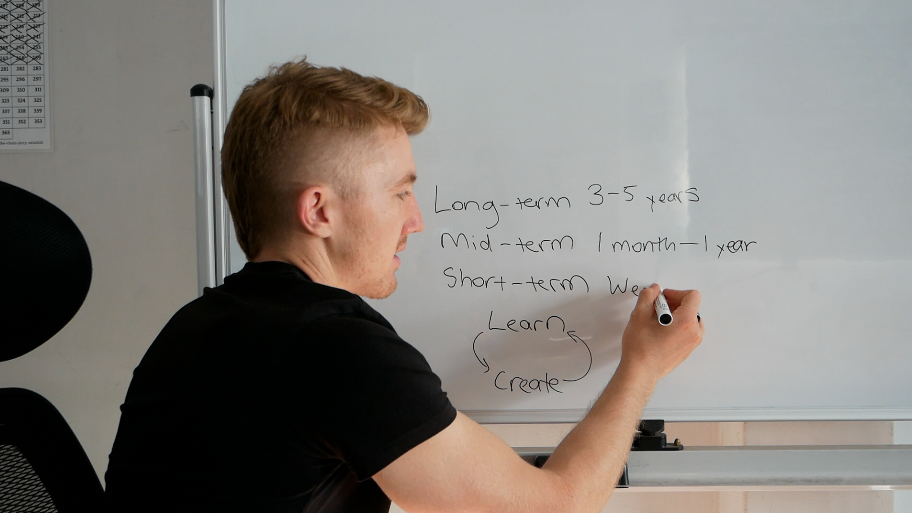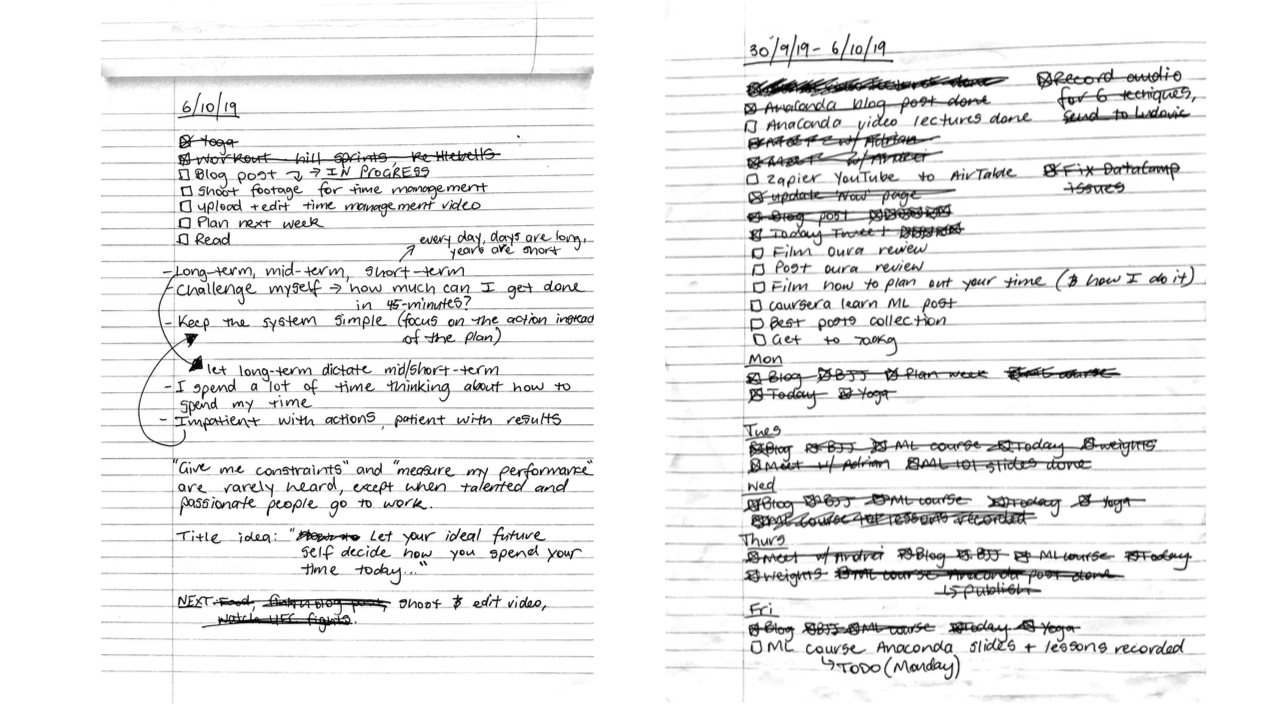How I became a productivity machine

I spend a lot of time thinking about how to spend my time. You might be the same.
I’ve tried every system you can imagine. Some worked, some didn’t. It’s no surprise the one I keep coming back to is simple.
My two guiding principles are less but better and creating to learn and learning to create. Most of what I do gets weighed up against these two. If there’s a match, I do it. If not, I ignore it.
I start with the long-term and work backwards.
Long-term
2-years ago, I did a test online called Understand Myself and another called Future Self Authoring Program. They’re psychology tests which give you an understanding of what kind of person you are and what you want to do in the future.
Both are valuable but the Future Self Authoring Program is what helped me figure out some of the things here.
The idea is simple. You write down your ideal person you would like to be in 3-5 years.
The sky is the limit. You can be working any job you like, have any skill you choose, be in a relationship with someone, have accomplished some major goal. How do you treat other people? How do you talk to yourself? Include it all.
Remember, it’s the ideal person you want to be. Don’t hold back. Go all out.
You should do this exercise in private. Take as much time as you need. Really sit there and think, who do I want to be? Who could I be?
3-5 years is an ideal timeframe because it’s not too far away and not too close. Plus, think about yourself 5 years ago, would you really want them making decisions for you now?
Doing the Future Self Authoring Program is where I figured out my guiding principles.
Specifically, my ideal self:
- Worked for himself (freelance or starting a business).
- Was healthy, physically and mentally.
- Didn’t need a partner but had good relationships with those closest to him, including himself.
- Was a paid creator.
- Could travel the world with a laptop and earn money online.
- Could code.
- Followed his curiosity, learned what he wanted to learn, and shared what he learned.
These were 2-years ago. And I’m lucky enough to have achieved most of them. But it’s important to remember, when I started, I couldn’t code, I wasn’t a paid creator, I had never made a single dollar online, I had a job and my relationship with myself could definitely have been improved. I’d gone through a breakup and realised most of my self-worth was tied up in the relationship instead of internally.
Once you’ve got some points down about your ideal self, see what they have in common.
Many of the main points of my ideal self involved learning and creating. That’s where I figured out the circle, learning to create and creating to learn.
You can do this exercise yourself. Whether it’s through the Future Self Authoring Program or just on your own. Think about your ideal self in 3-5 years, write them down. You’ll get lost in thought but you’ll remember them if they’re written down.
Once you’ve got an idea of the longer-term, you can start to work backwards, figuring out what you need to do in the shorter and medium term to get there.
Mid-term
3-5 years is a long-term timeframe. Mid-term is anything in a year, month or 6 week block. The specific timeframes vary but these are enough to get an idea.
I knew I wanted to be able to work for myself. And be able to work anywhere in world. To not have a set location I had to be at a certain time. To be a paid creator.
This meant I needed a skill. I needed a skill I could use to bring value to people and get paid for it.
I’d wanted to code for a long time. And I’d read stories of people working remotely being developers. So that’s where I decided to start.
And since one of my points was sharing what I’d learned. I decided to throw writing and video making in there. Since they could double as a creative outlet.
Now I had a rough idea of what I wanted to do. So I could break down the months, break down the six week blocks. 2017 was the year. I told myself. This year I’m going to learn to code. And I’m going to share my journey along the way.
Since I wanted to learn to code, specifically artificial intelligence and machine learning code, my mid-term actions were to go through online coding courses.
To help structure things, I did my research and made my own AI Masters Degree.
I’d say, “This month I’m going to go through everything in the Coursera Machine Learning Specialization by Andrew Ng.”
And, “I’m going to write an article and make a video every week sharing my progress.”
Short-term
The short-term actions are the ones you’ll be focusing on day to day or week to week.
They’re also some of the hardest. Because what you do day to day might not seem like much.
You might study something all day and seem like you’ve made no progress.
You might do a workout and eat healthily one day but the scale doesn’t change the next.
What’s important to remember is short-term actions add up overtime.
Once I figured out where I’d like my long-term ideal self to be, I could start to think about what I needed to do in the short-term.
Work towards the long-term but don’t forget to enjoy the short-term.
Be impatient with actions but patient with results
If I know my mid-term goal is to complete a machine learning course, what can I control?
I can’t control how much progress I make in a day. But I can control how much time I spend towards it.
I’d say things like “Today, I’m going to spend 6 pomodoros (25-minute sessions) studying machine learning.”
Instead of being worried about progressing to the next stage of the course, all I had to do was sit there and learn for 3-hours.
You should have a bias towards action. Try something, see if it works, if it doesn’t, reassess and try again.
In the beginning, your results won’t match your actions. But keep them going long enough and the results will come.
Keep the system simple
Name a to-do list app and I’ve tried it. I was looking for the silver bullet, an app which would help me do the work. No such app or system exists.
The best system is one you can adhere to.
Mine is a combination of paper, writing and Trello.
For the short-term, I use paper. For mid to long-term I use Trello.
Why paper? I’m a visual person. I like to see things happening.
At the start of the week, I’ll write a list of things which need to happen during the week on one sheet of paper.
At the start of the day, I’ll write a list of things which need to happen during the day on another sheet of paper.

What goes on these lists is based on what’s in my Trello board. I use the Kanban style. One column has things I want to do. Another column has things which are in progress. And the other columns have things which have been done. You can see a demo version here.
My ideal self learns to create and creates to learn. So both of these are daily. Since, my ideal self is also healthy, movement is there too. They’re ingrained as habits now.
Every day I:
- Write
- Create (this can be writing, video making, cooking, whatever gets you to think)
- Learn (reading, thinking, writing)
- Move

Daily is great because it removes the number of things you have to think about. It makes things binary.
“Did you write today?”
“Not yet.”
Well better write.
Challenge yourself
I sat down to write this post and set a 45-minute timer.
“What can I get done in the next 45-minutes?”
45-minutes later, we’re at 1000 words.
Things will get hard. You know they will. But that’s the fun part.
Have you ever tried coaching a group of kids?
I was at Jiu Jitsu the other day. Robbie’s the head coach. He’s running a class of a dozen or so 7-year-olds.
By the tail end of the 30-minute class, their concentration is off the rails. But class isn’t finished yet and there’s still a technique Robbie would like to go through.
What happens?
He turns it into a competition.
“Okay kids, who can do the best bear crawls?”
What do think happened next?
A dozen 7-year-olds are walking around doing the best bear crawls you’ve ever seen.
You can take this principle and apply it to yourself. Turn your short-term actions into a competition.
I talk to myself about it.
“Okay Daniel, how much can you get done today?”
“How much can you get done this week?”
Find your limit.
2nd, 3rd, 4th order processes
The new Call of Duty comes out later this month. I told Dave at the start of the month, if I can write an article to pay for a new Xbox and the game, I’ll buy one.
I wrote the article, got the money. But I’m not buying the Xbox.
Why?
Silly me. I forgot about the 2nd, 3rd and 4th order processes.
On the surface, it seems harmless. I did the work, the Xbox is my reward.
Buying the Xbox and Call of Duty is a 1st order process. $400 and a little setup time and I’m ready to play.
But then comes the 2nd order process. Now I’ve bought the Xbox, my time will be used to play it.
And the 3rd order process. Since I’ve started playing and since the Xbox is there, I’ll tell myself, to make the purchase worthwhile, I’ll have to keep playing it.
Then the 4th order process. Once the initial hype is over, and it’s 6-months later. Will I still want the Xbox? Probably not.
On the surface, the 1st order process, something may look attractive. But go a few levels deeper and it loses its shine.
My ideal future self didn’t have video game player on his list.
What’s the alternative?
To test things, every once in a while, screw up the routine, add some randomness. See what you miss. Ask yourself.
What if I set aside my current plans for the time being and tried the simplest option?
Instead of adding more, how about taking away? Less but better.
You’re not after perfect, you’re after progress
Do all the things on the lists always get done?
No. Of course not. Life happens.
Yesterday I didn’t tick all the boxes. Last week I didn’t tick all the boxes.
There’s still a list of things I suck at. Email, exact deadlines for myself, I’m still a rough ballpark kind of operator, replying to all notifications.
It’s okay. I’m content at being bad some things in order to improve at others.
What can you do?
Sit down, write down what your ideal future self looks like in 3-5 years. Be specific as you want, be general as you want. Don’t hold back.
Treat your ideal future self as your long-term project. Then work backwards. Use the long-term as a sign post and base your mid-term and short-term actions on the steps you need to take to get there.
You can see the video version of this article on YouTube.
